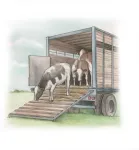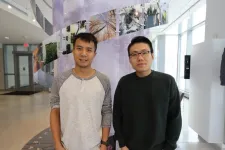(Press-News.org) New database of 928 species of weeds from Universities of Sheffield and Oxford published to provide free, global resource for plant ecologists and archaeologists
The data changes our understanding of the history of agriculture as well as ability to understand the future of our farming practices in a time of climate change
The project, based on 30 years of research partnerships, is a testament to how academics of different disciplines can collaborate on globally significant research
A new database of weeds that can help scientists understand how traditional agricultural systems were managed throughout history, could also provide insights into how global trends like the climate crisis could affect the resilience of our modern day food systems.
The database is the culmination of 30 years of collaborative research from archaeologists and ecologists working at the Universities of Sheffield and Oxford. It catalogues nearly 1000 species of weeds growing in traditional agricultural regimes in Europe, Western Asia and North Africa.
The open access resource, created and published by academics continuing the research project through the Oxford University Research Archive, offers researchers worldwide the opportunity to compare archaeobotanical data with ’traditional’ farming systems.
The database catalogues the functional traits of weeds growing amongst arable cereal and pulse crops for all 928 weed species. The aim of the project was to be able to compare past and present farming systems through the weeds that grow alongside arable crops.
Plant ecologist, John Hodgson, who worked at what is now the University of Sheffield’s School of Biosciences, was involved in the research from the 1990s. He said: “The data gives archaeologists and plant ecologists a way to understand the past and predict the future together.
“In modern day agricultural environments, where crops are micromanaged and everything that is not wanted is removed, it can be difficult to monitor long term changes to environments and plant species. So by investigating historical weed populations, instead of the crops, the data offers researchers a unique way to see what has been lost and gained over the ages.
“Analysis of the data allows us to look at what kind of plants have the ability to adapt to, or may be vulnerable to changing conditions in their habitats. The robust data from this years-long research offers the potential for understanding the resilience of food systems in a time of climate change, drought and degradation of land, and the exploration of a narrative for issues the world is facing today in terms of global food production.”
The data models contained in the new package look to understand how low input (extensive) farming and high input (intensive) arable agriculture compare, which offers a free resource for academics to understand the nature of crop cultivation at field research sites, including how much labour people were investing in agricultural practices at a given time and what this may say about the sites and their inhabitants.
Glynis Jones, Emeritus Professor of Archaeology at the University of Sheffield, commented that the data has uncovered new insights about the history of agriculture and changed our understanding of the development of farming globally. She said: “The aim of the project was to use relatively simple functional attributes of different plant species, that can be measured more quickly than expensive and time-consuming experiments, to give us some entirely new insights into historical sites.
“We tend to assume agriculture started off in a non-intensive fashion, and grew progressively more intensive over the ages. However we have found Neolithic and Bronze Age sites that challenge this belief, small patches of land that were farmed intensively, using practices such as fertilising, watering and weeding crops like wheat or barley; places where there was a lot of human effort being put into the growing of crops.
“We also found that sites from the Iron Age and Roman period that encompassed more extensive areas were less intensively cultivated, so more crops may be grown but they would not be farmed as intensively as before as they covered larger areas. Whereas modern agriculture is characterised by encompassing both intensive and extensive agricultural practices.
“Our research has revealed to us the trends in arable agriculture over time and how farming practices have varied in different environments.”
Those involved with the database say it forms a key research resource for academics working in ecology and archaeobotany. It is the culmination of 30 years of research from current and previous academics at the University of Sheffield and those now at the University of Oxford, including Professor of Environmental Archaeology, Mike Charles and Professor of European Archaeology, Amy Bogaard who led the work to create the new R package ‘WeedEco’ which is open access for all.
Elizabeth Stroud, from the University of Oxford, who led development of the new R package WeedEco, said: “The new publication for the first time makes these datasets and models accessible to anyone interested in comparative study of past and present arable farming. This means that anyone from developer-funded or university-based archaeology, or from the plant science and ecology side, can engage directly with this research and conduct their own analyses. The models we are releasing in the R package have featured prominently in recent farming-related research projects in the University of Oxford’s School of Archaeology, such as FeedSax and AgricUrb. This work has shed new light on how a range of different societies through time produced their staple crops.”
Amy Bogaard, from the University of Oxford and senior author on the latest study, notes: “The new R package and the newly published dataset of functional traits for nearly 1000 weed species is a testimony to the dedication of everyone involved, and above all to the vision and commitment of colleagues at the University of Sheffield, where the functional ecological approach, and the connection to archaeobotany, originated. This is very much a joint celebration with colleagues in Sheffield and the School of Archaeology in Oxford.”
ENDS
Media contact: Rebecca Ferguson, Media and PR Officer, 0114 222 3670, r.l.ferguson@sheffield.ac.uk
Notes to editors:
A publication of methods used to apply the information in the dataset to archaeobotanical material can be found at Vegetation History and Archaeobotany.
The University of Sheffield
The University of Sheffield is a leading Russell Group university, with a world-class reputation. Over 30,000 students from 150 countries study at Sheffield. In a truly global community, they learn alongside over 1,500 of the world’s leading academics.
Sheffield’s world-shaping research feeds into its excellent education. Students learn at the leading edge of discovery from researchers who are tackling today’s biggest global challenges.
Driven by outstanding people, staff and students share a commitment to changing the world for the better, through the power and application of ideas and knowledge.
From the first documented use of penicillin as a therapy in 1930, to building Europe’s largest research-led manufacturing cluster, Sheffield’s inventive spirit and top quality research environment sets it apart.
Current research partners include Boeing, Rolls-Royce, Unilever, AstraZeneca, GlaxoSmithKline, Siemens and Airbus, as well as many government agencies and charitable foundations.
Sheffield’s Students’ Union has won the Whatuni Student Choice Award for Best Students’ Union for six consecutive years. Students can choose from 350 societies and clubs, or join over 2,000 volunteers.
Over 300,000 Sheffield alumni from 205 different countries make a significant influence across the world, with six Nobel Prize winners included amongst former staff and students.
To find out more, visit: www.sheffield.ac.uk
END
World's largest database of weeds lets scientists peer into the past, and future, of global agriculture
2024-01-24
ELSE PRESS RELEASES FROM THIS DATE:
Live animal transport regulations not ‘fit for purpose’, major international study finds
2024-01-24
A ‘fitness check’ of regulations in five countries meant to protect animals during transportation, has deemed that they all fall short of fully protecting animals during transport. Findings from this interdisciplinary work involving animal welfare scientists and a law lecturer which compared animal transport rules designed to protect the billions of livestock that are transported on lengthy journeys in Australia, Canada, New Zealand, EU (including UK) and US, highlights serious failures.
The study, published in Royal Society Open Science today [Wednesday 24 January], and involving researchers from the Universities ...
Mind the (green) gap
2024-01-23
Color mixing is the process of combining two or more colors: red and green make yellow, blue and red make purple, red and green and blue make white. This process of mixing colors is the basis for the future of solid-state lighting. While currently white light is achieved by phosphor down-conversion, LED color mixing actually has a higher theoretical maximum efficiency, which is needed in order to achieve the 2035 DOE energy efficiency goals. Despite the potential efficiency of color-mixed LED sources, there exists one significant challenge: green. ...
Injectable water filtration system could improve access to clean drinking water around the world
2024-01-23
More than 2 billion people, approximately a quarter of the world’s population, lack access to clean drinking water. A new, portable and affordable water filtration solution created by researchers at The University of Texas at Austin aims to change that.
The new system collects dirty water with a syringe and injects it into a hydrogel filter that weeds out nearly all tiny particles. This device, the researchers say, offers significant advantages in cost, simplicity, effectiveness and sustainability compared existing commercial options, giving users the ability to easily decontaminate water from nearby streams and ...
Gravity helps show strong force strength in the proton
2024-01-23
The power of gravity is writ large across our visible universe. It can be seen in the lock step of moons as they circle planets; in wandering comets pulled off-course by massive stars; and in the swirl of gigantic galaxies. These awesome displays showcase gravity’s influence at the largest scales of matter. Now, nuclear physicists are discovering that gravity also has much to offer at matter’s smallest scales.
New research conducted by nuclear physicists at the U.S. Department of Energy’s Thomas Jefferson National Accelerator Facility is using a method that connects theories of gravitation to interactions among the smallest ...
Cleveland Clinic and IBM Researchers publish findings on artificial intelligence and immunity
2024-01-23
Researchers from Cleveland Clinic and IBM have published a strategy for identifying new targets for immunotherapy through artificial intelligence (AI). This is the first peer-reviewed publication from the two organizations’ Discovery Accelerator partnership, designed to advance research in healthcare and life sciences.
The team worked together to develop supervised and unsupervised AI to reveal the molecular characteristics of peptide antigens, small pieces of protein molecules immune cells use to recognize threats. Project members ...
When some adolescent girls internalize rejection, it really is in their head
2024-01-23
Everyone ruminates about the bad things that happen to them. Whether it’s a nasty breakup, an embarrassing failure or simply when someone is mean, it can be hard to stop thinking about what happened and why. For people who ruminate too much, this negative thought pattern can cause lasting problems with mental health.
A research team led from the University of California, Davis, Center for Mind and Brain found that adolescent girls who have a stronger tendency to ruminate show different patterns of brain activity when faced with social rejection. The study was ...
Researchers design new open-source technology for interfacing with living neurons
2024-01-23
Neurons intricately communicate and respond to stimuli within a vast network, orchestrating essential functions from basic bodily processes to complex thoughts. Traditional neuroscience methods, relying on in vivo electrophysiology (within a living organism), often have difficulty addressing the complexity of the brain as a whole. An alternative approach involves extracting cells from the organism and conducting studies on a culture dish instead (in vitro), providing researchers with enhanced control and precision in measuring neural processes. In a new study featured in Advanced Science, researchers unveil a cost-effective, open-source in vitro system ...
Why do young women with multiple sclerosis face health disparities?
2024-01-23
While recent therapies have the potential to stall or delay the progression of multiple sclerosis, a new study shows that young Black and Hispanic women fare worse than young white women.
Minority women were more likely to have more advanced disease and faced greater challenges in pregnancy, the researchers reported in their study, publishing in the journal Neurology on Jan. 23, 2024.
Researchers tracked medical records at nine MS centers throughout the country for 294 women whose pregnancies resulted in live births. Approximately half of the patients ...
Could two drugs be better than one for treating prostate cancer?
2024-01-23
Combining testosterone-blocking drugs in patients with prostate cancer relapse prevents the spread of cancer better than treatment with a single drug, a multi-institution, Phase 3 clinical trial led by UC San Francisco researchers has found.
The approach can extend the time between debilitating drug treatments without prolonging the time it takes to recover from each treatment.
Prostate cancer affects 1 in 8 men and causes 34,000 deaths each year in the United States. It is usually treated with one of several testosterone-lowering drugs for a set period of ...
Predicting and controlling bad-actor AI activity in a year of global elections
2024-01-23
MEDIA CONTACT:
Cate Douglass; cdouglass@gwu.edu
More than 50 countries are set to hold national elections this year and analysts have long sounded the alarm on the threat of bad actors using artificial intelligence (AI) to disseminate and amplify disinformation during the election season across the globe.
Now, a new study led by researchers at the George Washington University predicts that daily, bad-actor AI activity is going to escalate by mid-2024, increasing the threat that it could affect election results. The research, published today in the journal PNAS Nexus, is the first quantitative scientific ...




